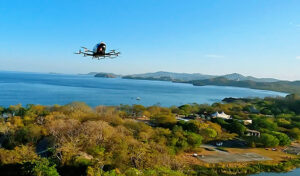Reaching for the clouds at Manchester’s air quality ‘supersite’
AQN editor Thomas Barrett recently visited the University of Manchester’s new air quality ‘supersite’, which could radically change how we understand air pollution.
Four shipping containers placed on top of each other in the University of Manchester’s Fallowfield campus might not seem like the most hi-tech way to house millions of pounds worth of air quality equipment, but this could be the place that transforms how we understand sources of urban air pollution.
Dr Nick Marsden, a scientist at the university, talked us through the dazzling array of kit that measures everything from black carbon in the air to particulates in the clouds. It’s been funded as part of a £6m investment into three new air quality supersites — the other sites are in the University Birmingham and King’s College London— established by the Natural Environment Research Council (NERC).
The three sites will help to improve the understanding of different sources of urban air pollution through its main OSCAR project. The supersites also include stateof-the-art instruments that detect a variety of greenhouse gases and ozone depleting chemicals.
Excited by the possibilities
Dr Marsden has been here most days since the cabins became operational in August 2019 and is excited at the possibilities that the data will offer.
‘The evidence [on air pollution] is growing all the time,’ he says. ‘But what isn’t growing are the reasons why air pollution does what it does, which is one of the reasons we are doing research in the field like this.’
‘The data will reduce uncertainty in estimates of current real-world emissions of NOx and PM in road transport, non-tailpipe and exhaust and give a more accurate picture of what is measured.’
Unlike Defra’s AURN monitors that are located across the country, they are not doing just monitoring, they are being used for scientific research as well. ‘Quite often, you get lots of air quality monitoring sites but you can’t do research there because they are just for monitoring, but here, we want to do research, so understanding sources and different measurements,’ says Dr Marsden.
There are machines that suck in air from outside and measure elements in the gas, ammonia, ozone, NO2 and multi-carbon. Every 10 seconds they get different samples. The data is then collected and shared with whoever might need it, from policymakers to other scientists to the general public.
What makes the supersite at the cutting edge of monitoring particulates is that not only does it measure levels of particulates, it studies what they are made up of, from ammonia, sulphates, nitrate and chlorine in particles, which Nick says is hugely important for understanding non-exhaust emission sources from brakes or tyres.
Science capabilities
Academics and PhD students are already working on this data to interpret it, analysing particulate matter to a level of detail that’s not usually done. The data is also being shared at the other sites in Birmingham and London, where everything is being done the same.
They do the inlets in the same way and where possible, they use the same instruments so they can make accurate comparisons. But what sticks out to Dr Marsden, is that the sites will provide a data resource and experimental platform to enable an application of further science capabilities. ‘What we’ve got here is quite unique, that we have all these instruments in one space, but we also have spare lab space,’ he says.
‘We hope it will be interdisciplinary. What we want is engagement from the medical experts to make measurements with us.’ ‘What tends to happen is they work separately, and the clinical experiments take place in simulated conditions which are not necessarily representative of the real-world.’
‘We want to invite collaboration to do studies here, where the air is extremely well characterised, in a realworld situation.’ But as complex as the streams of data and machinery are, Nick says solving the air pollution conundrum will come down to something much more obvious. ‘Fewer car journeys are the only real way to stop pollution as far as I can see and more public transport.’
Cloudbusting
The supersite not only measures pollutants it will add knowledge to how weather shapes air quality and vice versa. On the rooftop, there is a mass spectrometer that takes individual particles, vapourising them, and measuring the chemical composition.
There are also wind speed direction measurements, a raindrop distrometer, and ceilometer to measure cloud height and concentrations. This fires laser pulses into the air that reflect back off the cloud so you can see the height of the cloud and find out what particles are inside.
The supersite really is reaching for the clouds, but on the ground, it doesn’t get more real-world than the building
site next door to the supersite, where a congregation of builders shout, diggers groan and tools whack.
There is dust everywhere. When back inside, Nick shows me the machine that monitors PM2.5 levels, pointing out a seismic peak of over 500 ug/m3. ‘I know what time the builders come to work, put it that way,’ he says.













